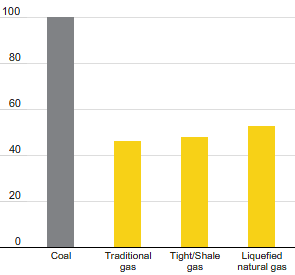GHG EMISSIONS FROM SOURCE TO
POWER GENERATION indexed to coal

Source: U.S. Department of Energy, National Energy
Technology Laboratory, October 2011
Global population will grow rapidly over the next few decades, and living standards are expected to continue improving. Many people in developing countries will rise out of poverty. Demand for energy is expected to rise by almost 80% by 2050.
All energy sources will be needed to meet demand in the coming years. Renewables including wind and solar power will continue to grow, reaching perhaps 30% of the world’s energy mix by 2050, with strong government support. By the same year, fossil fuels are expected to still meet around 65% of energy demand. With the level of CO2 in the atmosphere approaching 400 parts per million, the International Energy Agency (IEA) has made clear that the chances of limiting global temperature rise to a relatively safe 2 ºC are slipping away and that urgent steps are needed to reduce CO2 emissions.
Greater energy efficiency will help. But if the world is to avoid the effects of serious climate change, it needs decisive action now by governments, industry and consumers to at least halve global CO2 emissions in the coming decades.
Putting a price on carbon
A strong, stable price for CO2 within a comprehensive policy framework is needed to achieve significant emissions reductions in the long term. Governments should allow market forces to encourage the use of all technologies to reduce CO2 emissions, starting with those that are least costly and quickest to implement. In a positive step in 2012, Australia linked its developing carbon market with that of the European Union. We welcomed the progress made during the 2012 UN Climate Change Conference in Doha, Qatar, including the decision to continue the Kyoto Protocol, but substantial work will be needed over the coming years to reach a global agreement.
At Shell, however, we are not waiting for government policies or international coalitions to emerge. We are taking action today, with the focus on delivering results in four main areas.
Natural gas
More than one-third of CO2 emissions from the energy system come from electricity generation, making it a priority to reduce greenhouse gas (GHG) emissions in the power industry. From production through to use in generating electricity, natural gas produces around half the GHG emissions compared to coal. This applies across a range of production, processing and transportation methods (see chart above). Replacing coal with natural gas in the power sector is the quickest, most affordable route for many countries to achieve their CO2 reduction targets. Our production of natural gas is rising: in 2012 it accounted for almost half our production of energy resources. We are one of the world’s largest distributors of liquefied natural gas.
Carbon capture and storage
The IEA estimates that if carbon capture and storage (CCS) moves rapidly from demonstration phase to widespread use, it could reduce global CO2 emissions by around 20% by 2050. Shell is helping to advance CCS technologies in a number of projects. More government funding and a strong price on CO2 emissions are needed to move forward these projects for use in wider industry, as CCS projects currently generate no revenue for companies.
In 2012, we began construction of our Quest CCS project in Canada, which will potentially store over 1 million tonnes of CO2 a year from our oil sands operations from around 2015. Quest is designed to demonstrate a combination of technologies to capture, transport and store CO2 deep underground. The knowledge it will provide is expected to help develop a wider and more cost-effective use of CCS within the energy industry and other sectors in the years to come.
Other CCS projects Shell is involved in include the Technology Centre Mongstad in Norway, the world’s largest facility to develop and test CO2 capture technology, which opened in 2012. The Gorgon LNG project (Shell interest 25%) off the coast of Western Australia will include the world’s largest CCS project, once in operation around the middle of this decade. It is expected to store 3 to 4 million tonnes of CO2 a year.
Biofuels
Around 17% of global CO2 emissions from fossil fuels come from road transport. Shell believes low-carbon biofuels are one of the quickest, most practical routes to reducing CO2 emissions from the transport fuel mix in the next 20 years. Through our joint venture Raízen, Shell produces low-carbon biofuel: ethanol made from sugar cane in Brazil. This biofuel can reduce CO2 emissions by around 70% compared to petrol, from cultivation of the sugar cane to using the ethanol as fuel. We continue to work with partners to develop advanced biofuels for the future from non-food sources.
Energy efficiency
Shell has long-term multibillion-dollar programmes in place to improve the energy efficiency of our operations. These include our oil and gas production projects, oil refineries and chemical plants. We also offer products and services to help customers use less energy, including advanced fuels and lubricants.
Adaptation
In addition to our actions in these four areas, we are working to understand the potential physical impact of climate change in the future on our facilities and new projects.
